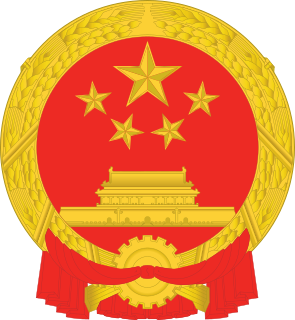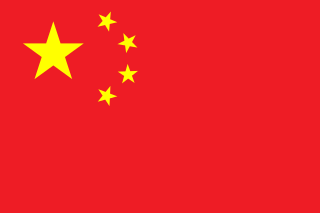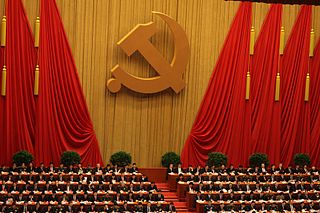 W
WThe History of the People's Republic of China details the history of mainland China since 1 October 1949, when Mao Zedong proclaimed the People's Republic of China (PRC) from atop Tiananmen, after a near complete victory (1949) by the Chinese Communist Party (CCP) in the Chinese Civil War. The PRC has for seven decades been synonymous with China, but it is only the most recent political entity to govern mainland China, preceded by the Republic of China (ROC) and thousands of years of imperial dynasties. The paramount leaders have been Mao Zedong (1949-1976), while Hua Guofeng briefly acted as the leader of the country during a transition period (1976-1978), Deng Xiaoping (1978-1989), Jiang Zemin (1989-2002), Hu Jintao (2002-2012) and Xi Jinping.
 W
WThe time period in China from 1949 and 1976 is commonly known as Maoist China. The history of the People's Republic of China is often divided distinctly by historians into the Mao era and the post-Mao era. The country's Mao era lasted from the founding of the People's Republic on 1 October 1949 to Deng Xiaoping's consolidation of power and policy reversal at the Third Plenum of the 11th Party Congress on 22 December 1978. The Mao era focuses on Mao Zedong's social movements from the early 1950s on, including land reform, the Great Leap Forward and the Cultural Revolution.
 W
WThe time period in China from 1976 and 1989 is often known as Dengist China. In September 1976, after Chairman Mao Zedong's death, the People's Republic of China was left with no central authority figure, either symbolically or administratively. The Gang of Four was dismantled, but new Chairman Hua Guofeng continued to persist on Mao-era policies. After a bloodless power struggle, Deng Xiaoping came to the helm to reform the Chinese economy and government institutions in their entirety. Deng, however, was conservative with regard to wide-ranging political reform, and along with the combination of unforeseen problems that resulted from the economic reform policies, the country underwent another political crisis with the Tiananmen Square protests of 1989.
 W
WIn the People's Republic of China, Deng Xiaoping formally retired after the Tiananmen Square protests of 1989, to be succeeded by former Shanghai mayor Jiang Zemin. The crackdown in 1989 led to great woes in China's reputation globally, and sanctions resulted. The situation, however, would eventually stabilize. Deng's idea of checks and balances in the political system also saw its demise with Jiang consolidating power in the party, state and military. The 1990s saw healthy economic development, but the closing of state-owned enterprises and increasing levels of corruption and unemployment, along with environmental challenges continued to plague China, as the country saw the rise to materialism, crime, and new-age spiritual-religious movements such as Falun Gong. The 1990s also saw the peaceful handover of Hong Kong and Macau to Chinese control under the formula of One Country, Two Systems. China also saw a new surge of nationalism when facing crises abroad.
 W
WThe People's Republic of China became more influential economically in the 1990s and 2000s and was beginning to be widely recognized as an emerging superpower. In 2010, China became the world's second largest economy by GDP. At the same time, numerous social problems emerged and intensified. As Paramount leader Jiang Zemin, NPCSC Chairman Li Peng and PRC Premier Zhu Rongji, gradually retired from their position of power, "fourth-generation" leaders, led by CPC General Secretary Hu Jintao and Premier Wen Jiabao, faced with increasing social unrest, attempted to steer the country towards a new direction. From the path of focusing solely on economic development, Hu and Wen placed focus on creating an overall balance under the idea of the Scientific Outlook on Development to create a socialist harmonious society. In this process, there was an unprecedented shift in stance towards favouring rural development and farmers, as well as other generally populist policies. The Hu-Wen government, on the same token, attempted to restrict some personal freedoms, especially those associated with political content on the Internet.
 W
WA far-reaching campaign against corruption began in China following the conclusion of the 18th National Congress of the Communist Party of China in 2012. The campaign, carried out under the aegis of Xi Jinping, General Secretary of the Communist Party of China, was the largest organized anti-graft effort in the history of Communist rule in China.
 W
WJapanese history textbook controversies involve controversial content in one of the government-approved history textbooks used in the secondary education of Japan. The controversies primarily concern the Japanese nationalist efforts to whitewash the actions of the Empire of Japan during World War II.
 W
WChina is rather active in land reclamation. Since 1949 a large amount of artificial land has been reclaimed, mainly on its coastlines. China is among the countries which have built the most artificial land; from 1949 to 1990s, the total area of land reclaimed from the sea of China was about 13,000 km2.
 W
WLaogai, the abbreviation for Láodòng Gǎizào (劳动改造), which means reform through labor, is a criminal justice system involving the use of penal labour and prison farms in the People's Republic of China (PRC). Láogǎi is different from láojiào, or re-education through labor, which was the abolished administrative detention system for people who were not criminals but had committed minor offenses, and was intended to "reform offenders into law-abiding citizens". Persons who were detained in the laojiao were detained in facilities that were separate from those which comprised the general prison system of the laogai. Both systems, however, were based on penal labour.
 W
WThe founding of the People's Republic of China (PRC) was formally proclaimed by Mao Zedong, the Chairman of the Communist Party of China, on October 1, 1949 at 3:00 pm in Tiananmen Square in Beijing, the new capital of China. The formation of the Central People's Government of the PRC, the government of the new nation, was officially proclaimed during the proclamation speech at the founding ceremony.
 W
WProtests and uprisings in Tibet against the government of the People's Republic of China have occurred since 1950, and include the 1959 uprising, the 2008 uprising, and the subsequent self-immolation protests.
 W
WFor more than a century, China's leaders have called for rapid development of science and technology, and science policy has played a greater role in national politics in China than in many other countries. China's scientific and technical achievements have been impressive in many fields. Although it has been a relatively low-income, developing country, China has by its own efforts managed to develop nuclear weapons, the ability to launch and recover satellites, supercomputers, and high-yield hybrid rice, among others. But the development of science and technology has been uneven, and significant achievements in some fields are matched by low levels in others.
 W
WThe history of Tibet from 1950 to the present includes the Chinese invasion of Tibet in 1950, and the Battle of Chamdo. Before then, Tibet had been a "de-facto" independent state/province under the governance of the Republic of China. In 1951, Tibetan representatives in Beijing signed the Seventeen-point Agreement under duress, which affirmed China's sovereignty over Tibet while it simultaneously provided for an autonomous administration led by Tibet's spiritual leader, and then-political leader, the 14th Dalai Lama. During the 1959 Tibetan uprising, when Tibetans arose to prevent his possible assassination, the Dalai Lama escaped from Tibet to northern India where he established the Central Tibetan Administration, which rescinded the Seventeen-point Agreement. The majority of Tibet's land mass, including all of U-Tsang and areas of Kham and Amdo, was officially established in 1965 as Tibet Autonomous Region, within China.